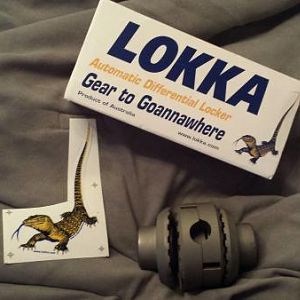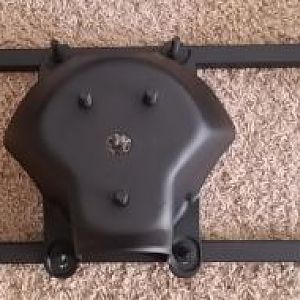profdlp
Fired
I have a 2007 Liberty which was the last year for the KJ. My Jeep has a build date of September 19, 2006 but I have seen references to some of the 2007s still using the old style PCV on the oil filler tube. Many parts places will send you the angled PCV if you order solely by model year (which happened to me), so have a look before you spend your money.
Instead of this:
You may need one of these:
Mopar Part# 53034065AA
It is located back here:
Here I have zoomed out to make it a little more clear:
You will need to remove the hose clamp from the rubber boot elbow. I ended up using the smallest pair of channel locks I had, since it was hard to fit any other tool in there. If you have a pair of those nice remote hose clamp pliers they would be ideal. Getting the boot off is a pain. I discovered that the new style PCV is actually a two piece affair and the easiest way to do this job is by removing the hose from the other end of the boot and twisting it counter-clockwise. This separates the two pieces and lets you remove the boot off the (brown) upper half in your garage, instead of while leaning clear to the back of the engine compartment. After that it was a simple matter to GENTLY pry the boot off with a flat tip screwdriver. You don't want to gouge it and give yourself more Positive Crankcase Ventilation than the good folks in Toledo intended. It also helps to have the engine good and warm when you do this as it softens up the rubber boot considerably. (Trying to do it cold I couldn't even twist the rascal.) Wear some gloves, because I gave myself a nice long blister trying to remove the hot boot with my bare hand.
You will need a 34mm socket to get the lower half out. It may look from the picture like there is room for a big crescent wrench, but there really isn't as it is nestled down between a lot of other stuff. Make sure you have a socket handle to match it. I didn't, and had to make a quick trip to the store to get an adapter to match the 1/2" drive socket to my 3/8" drive handle. Since it separates into two pieces you don't necessarily need an extra deep socket to remove the lower half where the nut is, though every socket that size I have seen is deep to begin with. If you have trouble finding it in your local chain auto parts store, check the axle socket section. Where I got mine they had them displayed separately from the regular sockets.
Here is a picture with the upper half removed. The green arrow shows where I slid the hose clamp back to so it would be out of the way and I wouldn't forget to put it back around the hose before snapping everything back together:
And here are the two halves. The arrows mark the bayonet-type thread where it comes apart:
Here is a view of the inside of the upper half:
And detail of the inside of the lower half:
The new style valve comes with the thread compound pre-applied. Don't be tempted to replace it with Teflon tape - that stuff would melt in no time and who knows what havoc that might cause.
If you have the tools on hand and follow the procedure, this would be a ten minute job. It took me a lot longer since I was learning while doing. I hope this benefits some of you.
Jeep recommends replacing the PCV Valve every 50,000 miles. I paid $12 for the valve itself, so there's no good reason to leave a dirty old valve in there - you're going to end up paying a lot more than that in gas and performance. I just did this and will try and update this guide with any results I may see after I've driven around for a while with the new valve. I am currently at 58,000 miles, so I'm a little late in the game for getting this job done. Here's hoping for an extra mpg or two. :favorites13:
Instead of this:
You must be registered for see images attach
You may need one of these:
You must be registered for see images attach
Mopar Part# 53034065AA
It is located back here:
You must be registered for see images attach
Here I have zoomed out to make it a little more clear:
You must be registered for see images attach
You will need to remove the hose clamp from the rubber boot elbow. I ended up using the smallest pair of channel locks I had, since it was hard to fit any other tool in there. If you have a pair of those nice remote hose clamp pliers they would be ideal. Getting the boot off is a pain. I discovered that the new style PCV is actually a two piece affair and the easiest way to do this job is by removing the hose from the other end of the boot and twisting it counter-clockwise. This separates the two pieces and lets you remove the boot off the (brown) upper half in your garage, instead of while leaning clear to the back of the engine compartment. After that it was a simple matter to GENTLY pry the boot off with a flat tip screwdriver. You don't want to gouge it and give yourself more Positive Crankcase Ventilation than the good folks in Toledo intended. It also helps to have the engine good and warm when you do this as it softens up the rubber boot considerably. (Trying to do it cold I couldn't even twist the rascal.) Wear some gloves, because I gave myself a nice long blister trying to remove the hot boot with my bare hand.
You will need a 34mm socket to get the lower half out. It may look from the picture like there is room for a big crescent wrench, but there really isn't as it is nestled down between a lot of other stuff. Make sure you have a socket handle to match it. I didn't, and had to make a quick trip to the store to get an adapter to match the 1/2" drive socket to my 3/8" drive handle. Since it separates into two pieces you don't necessarily need an extra deep socket to remove the lower half where the nut is, though every socket that size I have seen is deep to begin with. If you have trouble finding it in your local chain auto parts store, check the axle socket section. Where I got mine they had them displayed separately from the regular sockets.
Here is a picture with the upper half removed. The green arrow shows where I slid the hose clamp back to so it would be out of the way and I wouldn't forget to put it back around the hose before snapping everything back together:
You must be registered for see images attach
And here are the two halves. The arrows mark the bayonet-type thread where it comes apart:
You must be registered for see images attach
Here is a view of the inside of the upper half:
You must be registered for see images attach
And detail of the inside of the lower half:
You must be registered for see images attach
The new style valve comes with the thread compound pre-applied. Don't be tempted to replace it with Teflon tape - that stuff would melt in no time and who knows what havoc that might cause.
If you have the tools on hand and follow the procedure, this would be a ten minute job. It took me a lot longer since I was learning while doing. I hope this benefits some of you.
Jeep recommends replacing the PCV Valve every 50,000 miles. I paid $12 for the valve itself, so there's no good reason to leave a dirty old valve in there - you're going to end up paying a lot more than that in gas and performance. I just did this and will try and update this guide with any results I may see after I've driven around for a while with the new valve. I am currently at 58,000 miles, so I'm a little late in the game for getting this job done. Here's hoping for an extra mpg or two. :favorites13:
Last edited:











